An official website of the United States government
 United States Department of Labor
United States Department of Labor
Plan, direct, or coordinate academic or nonacademic activities of preschools or childcare centers and programs, including before- and after-school care. Excludes “Preschool Teachers, Except Special Education” (25-2011) and “Childcare Workers” (39-9011).
Employment estimate and mean wage estimates for Education and Childcare Administrators, Preschool and Daycare:
| Employment (1) | Employment RSE (3) |
Mean hourly wage |
Mean annual wage (2) |
Wage RSE (3) |
|---|---|---|---|---|
| 64,090 | 1.7 % | $ 29.48 | $ 61,320 | 1.1 % |
Percentile wage estimates for Education and Childcare Administrators, Preschool and Daycare:
| Percentile | 10% | 25% | 50% (Median) |
75% | 90% |
|---|---|---|---|---|---|
| Hourly Wage | $ 17.57 | $ 21.36 | $ 26.10 | $ 33.34 | $ 45.62 |
| Annual Wage (2) | $ 36,550 | $ 44,420 | $ 54,290 | $ 69,350 | $ 94,890 |
Industries with the highest published employment and wages for Education and Childcare Administrators, Preschool and Daycare are provided. For a list of all industries with employment in Education and Childcare Administrators, Preschool and Daycare, see the Create Customized Tables function.
Industries with the highest levels of employment in Education and Childcare Administrators, Preschool and Daycare:
| Industry | Employment (1) | Percent of industry employment | Hourly mean wage | Annual mean wage (2) |
|---|---|---|---|---|
| Child Care Services | 52,900 | 5.63 | $ 28.44 | $ 59,160 |
| Elementary and Secondary Schools | 3,960 | 0.05 | $ 37.42 | $ 77,840 |
| Individual and Family Services | 1,600 | 0.05 | $ 32.31 | $ 67,210 |
| Religious Organizations | 870 | 0.45 | $ 29.78 | $ 61,940 |
| Civic and Social Organizations | 800 | 0.24 | $ 30.92 | $ 64,320 |
Industries with the highest concentration of employment in Education and Childcare Administrators, Preschool and Daycare:
| Industry | Employment (1) | Percent of industry employment | Hourly mean wage | Annual mean wage (2) |
|---|---|---|---|---|
| Child Care Services | 52,900 | 5.63 | $ 28.44 | $ 59,160 |
| Religious Organizations | 870 | 0.45 | $ 29.78 | $ 61,940 |
| Civic and Social Organizations | 800 | 0.24 | $ 30.92 | $ 64,320 |
| Social Advocacy Organizations | 300 | 0.12 | $ 28.84 | $ 59,980 |
| Other Schools and Instruction | 570 | 0.11 | $ 24.58 | $ 51,120 |
Top paying industries for Education and Childcare Administrators, Preschool and Daycare:
| Industry | Employment (1) | Percent of industry employment | Hourly mean wage | Annual mean wage (2) |
|---|---|---|---|---|
| State Government, excluding Schools and Hospitals (OEWS Designation) | 80 | (7) | $ 50.16 | $ 104,330 |
| Residential Intellectual and Developmental Disability, Mental Health, and Substance Abuse Facilities | 40 | 0.01 | $ 42.42 | $ 88,240 |
| Junior Colleges | 290 | 0.05 | $ 41.99 | $ 87,340 |
| Community Food and Housing, and Emergency and Other Relief Services | 60 | 0.03 | $ 41.40 | $ 86,120 |
| Technical and Trade Schools | 30 | 0.02 | $ 40.87 | $ 85,010 |
States and areas with the highest published employment, location quotients, and wages for Education and Childcare Administrators, Preschool and Daycare are provided. For a list of all areas with employment in Education and Childcare Administrators, Preschool and Daycare, see the Create Customized Tables function.
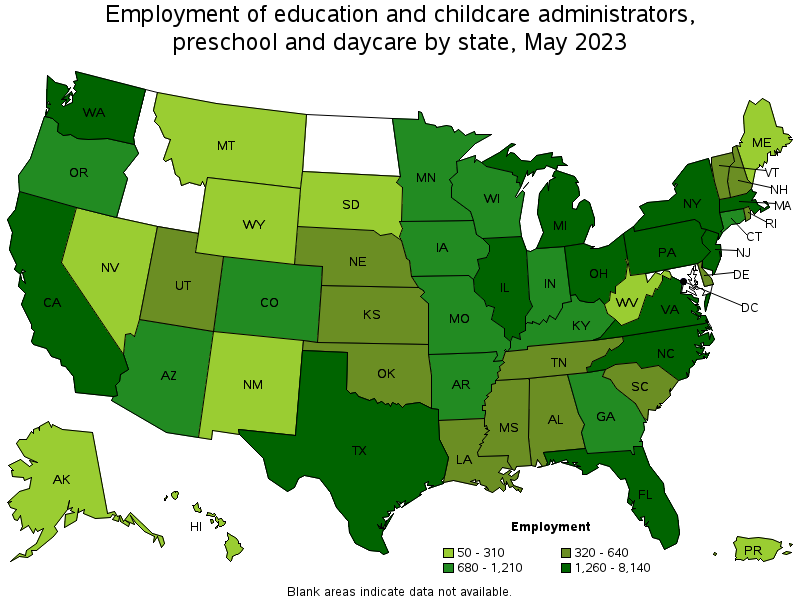
States with the highest employment level in Education and Childcare Administrators, Preschool and Daycare:
| State | Employment (1) | Employment per thousand jobs | Location quotient (9) | Hourly mean wage | Annual mean wage (2) |
|---|---|---|---|---|---|
| California | 8,140 | 0.45 | 1.08 | $ 35.09 | $ 72,990 |
| Texas | 6,470 | 0.48 | 1.13 | $ 25.00 | $ 52,000 |
| Florida | 4,910 | 0.51 | 1.22 | $ 26.42 | $ 54,950 |
| New York | 3,820 | 0.41 | 0.96 | $ 41.68 | $ 86,690 |
| Pennsylvania | 3,360 | 0.57 | 1.34 | $ 27.55 | $ 57,290 |
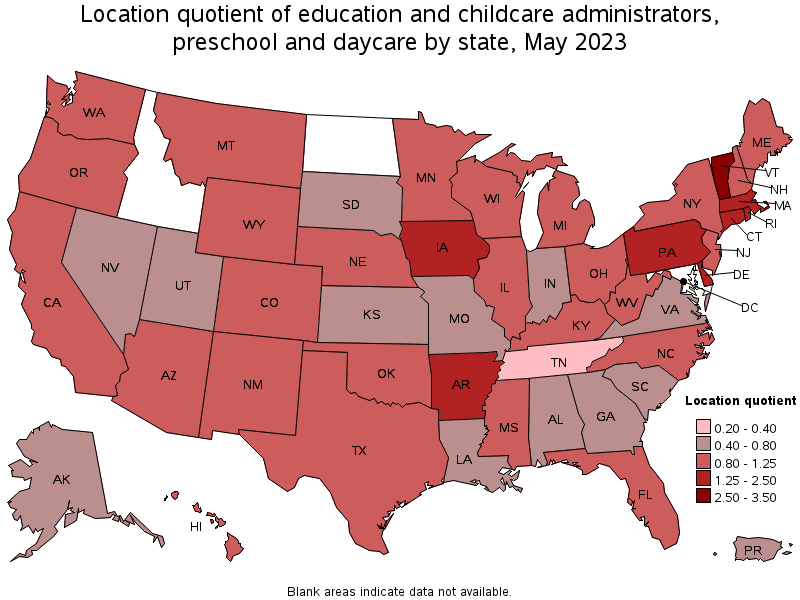
States with the highest concentration of jobs and location quotients in Education and Childcare Administrators, Preschool and Daycare:
| State | Employment (1) | Employment per thousand jobs | Location quotient (9) | Hourly mean wage | Annual mean wage (2) |
|---|---|---|---|---|---|
| Vermont | 320 | 1.06 | 2.50 | $ 28.77 | $ 59,840 |
| Rhode Island | 400 | 0.83 | 1.96 | $ 25.91 | $ 53,900 |
| Delaware | 360 | 0.77 | 1.83 | $ 29.93 | $ 62,260 |
| Arkansas | 910 | 0.72 | 1.70 | $ 22.43 | $ 46,660 |
| Iowa | 1,080 | 0.70 | 1.65 | $ 22.75 | $ 47,320 |
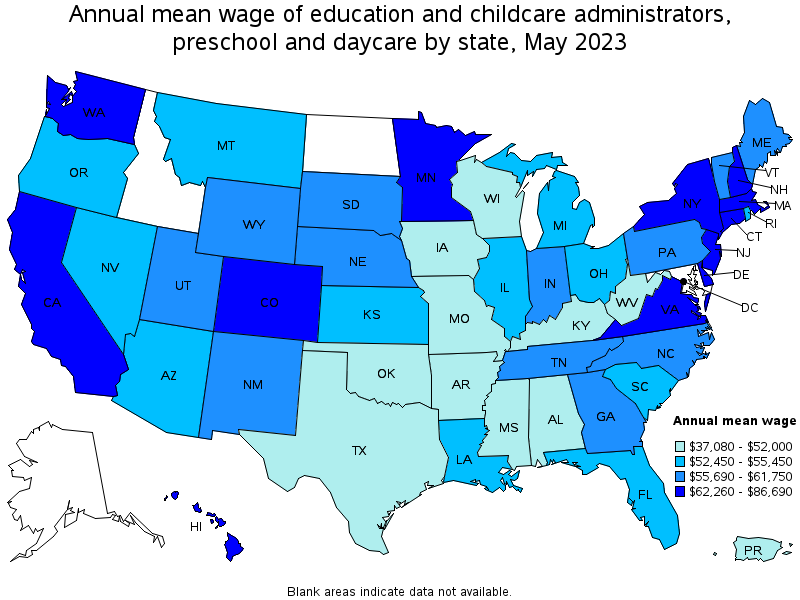
Top paying states for Education and Childcare Administrators, Preschool and Daycare:
| State | Employment (1) | Employment per thousand jobs | Location quotient (9) | Hourly mean wage | Annual mean wage (2) |
|---|---|---|---|---|---|
| New York | 3,820 | 0.41 | 0.96 | $ 41.68 | $ 86,690 |
| District of Columbia | 210 | 0.30 | 0.71 | $ 41.42 | $ 86,150 |
| New Jersey | 2,070 | 0.49 | 1.17 | $ 39.42 | $ 81,990 |
| California | 8,140 | 0.45 | 1.08 | $ 35.09 | $ 72,990 |
| Connecticut | 940 | 0.57 | 1.34 | $ 34.14 | $ 71,020 |
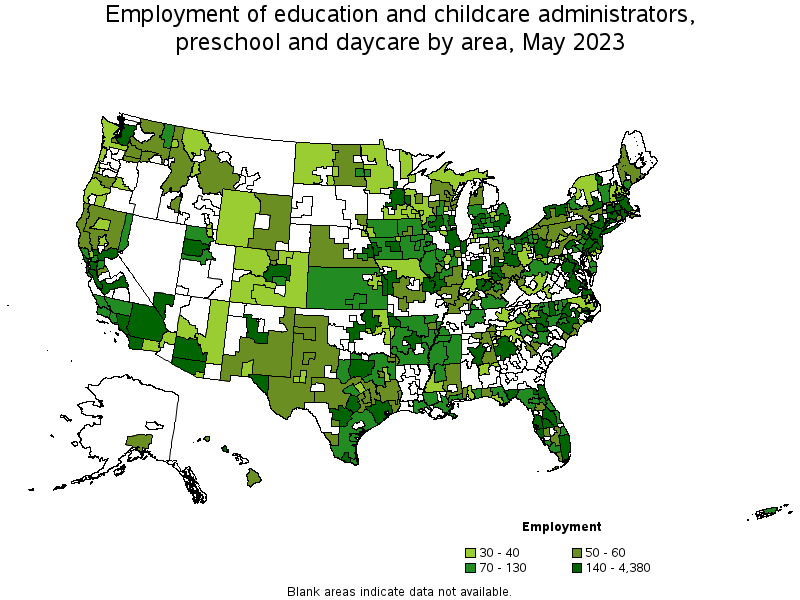
Metropolitan areas with the highest employment level in Education and Childcare Administrators, Preschool and Daycare:
| Metropolitan area | Employment (1) | Employment per thousand jobs | Location quotient (9) | Hourly mean wage | Annual mean wage (2) |
|---|---|---|---|---|---|
| New York-Newark-Jersey City, NY-NJ-PA | 4,380 | 0.46 | 1.09 | $ 43.36 | $ 90,180 |
| Los Angeles-Long Beach-Anaheim, CA | 2,910 | 0.47 | 1.11 | $ 32.54 | $ 67,680 |
| Philadelphia-Camden-Wilmington, PA-NJ-DE-MD | 2,360 | 0.83 | 1.97 | $ 30.05 | $ 62,490 |
| Houston-The Woodlands-Sugar Land, TX | 2,100 | 0.66 | 1.57 | $ 24.71 | $ 51,390 |
| Chicago-Naperville-Elgin, IL-IN-WI | 2,100 | 0.47 | 1.10 | $ 26.98 | $ 56,110 |
| Boston-Cambridge-Nashua, MA-NH | 1,940 | 0.70 | 1.66 | $ 33.91 | $ 70,530 |
| Dallas-Fort Worth-Arlington, TX | 1,650 | 0.42 | 0.99 | $ 26.64 | $ 55,410 |
| Washington-Arlington-Alexandria, DC-VA-MD-WV | 1,440 | 0.47 | 1.10 | $ 32.96 | $ 68,570 |
| San Francisco-Oakland-Hayward, CA | 1,340 | 0.55 | 1.31 | $ 41.16 | $ 85,610 |
| Miami-Fort Lauderdale-West Palm Beach, FL | 1,330 | 0.49 | 1.16 | $ 31.17 | $ 64,830 |
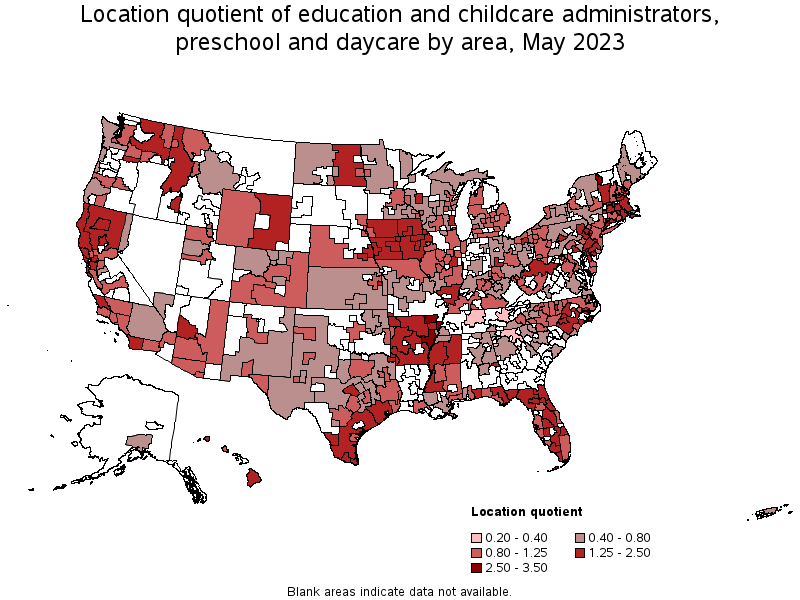
Metropolitan areas with the highest concentration of jobs and location quotients in Education and Childcare Administrators, Preschool and Daycare:
| Metropolitan area | Employment (1) | Employment per thousand jobs | Location quotient (9) | Hourly mean wage | Annual mean wage (2) |
|---|---|---|---|---|---|
| Burlington-South Burlington, VT | 140 | 1.17 | 2.77 | $ 26.89 | $ 55,920 |
| Iowa City, IA | 90 | 0.99 | 2.35 | $ 21.73 | $ 45,200 |
| Jonesboro, AR | 60 | 0.97 | 2.31 | $ 23.73 | $ 49,360 |
| New Bedford, MA | 60 | 0.88 | 2.09 | $ 32.18 | $ 66,920 |
| Texarkana, TX-AR | 50 | 0.85 | 2.01 | $ 21.15 | $ 43,990 |
| Philadelphia-Camden-Wilmington, PA-NJ-DE-MD | 2,360 | 0.83 | 1.97 | $ 30.05 | $ 62,490 |
| Jacksonville, NC | 40 | 0.81 | 1.92 | $ 25.11 | $ 52,230 |
| Lawrence, KS | 40 | 0.81 | 1.92 | $ 25.53 | $ 53,100 |
| Brownsville-Harlingen, TX | 120 | 0.80 | 1.90 | $ 22.87 | $ 47,570 |
| Providence-Warwick, RI-MA | 450 | 0.80 | 1.89 | $ 26.61 | $ 55,360 |
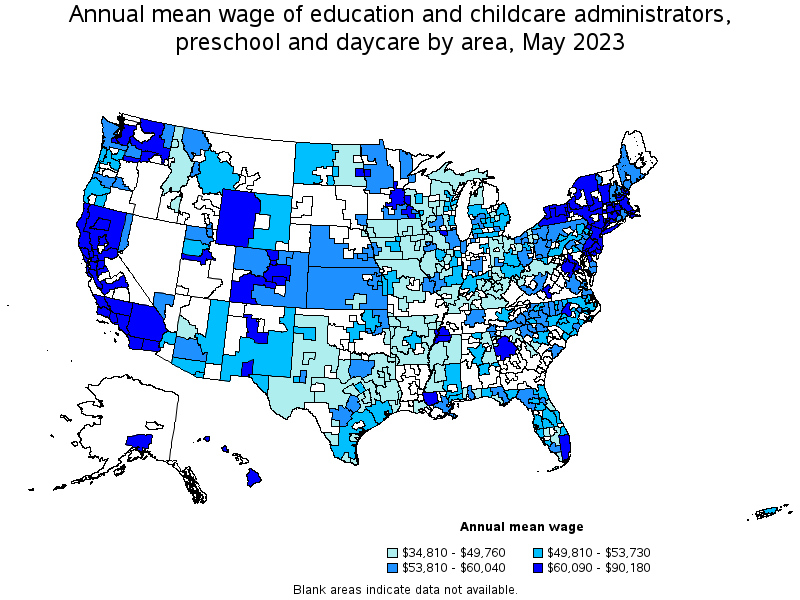
Top paying metropolitan areas for Education and Childcare Administrators, Preschool and Daycare:
| Metropolitan area | Employment (1) | Employment per thousand jobs | Location quotient (9) | Hourly mean wage | Annual mean wage (2) |
|---|---|---|---|---|---|
| New York-Newark-Jersey City, NY-NJ-PA | 4,380 | 0.46 | 1.09 | $ 43.36 | $ 90,180 |
| San Francisco-Oakland-Hayward, CA | 1,340 | 0.55 | 1.31 | $ 41.16 | $ 85,610 |
| San Jose-Sunnyvale-Santa Clara, CA | 560 | 0.49 | 1.17 | $ 41.05 | $ 85,390 |
| Bridgeport-Stamford-Norwalk, CT | 310 | 0.78 | 1.86 | $ 38.24 | $ 79,530 |
| Modesto, CA | 60 | 0.33 | 0.78 | $ 38.00 | $ 79,030 |
| San Diego-Carlsbad, CA | 820 | 0.54 | 1.28 | $ 36.95 | $ 76,850 |
| Napa, CA | 30 | 0.43 | 1.03 | $ 36.92 | $ 76,790 |
| Trenton, NJ | 140 | 0.58 | 1.37 | $ 36.91 | $ 76,780 |
| Riverside-San Bernardino-Ontario, CA | 470 | 0.28 | 0.67 | $ 36.41 | $ 75,730 |
| Syracuse, NY | 130 | 0.46 | 1.08 | $ 35.61 | $ 74,080 |
Nonmetropolitan areas with the highest employment in Education and Childcare Administrators, Preschool and Daycare:
| Nonmetropolitan area | Employment (1) | Employment per thousand jobs | Location quotient (9) | Hourly mean wage | Annual mean wage (2) |
|---|---|---|---|---|---|
| Southeast Coastal North Carolina nonmetropolitan area | 160 | 0.64 | 1.51 | $ 25.28 | $ 52,580 |
| Piedmont North Carolina nonmetropolitan area | 130 | 0.49 | 1.17 | $ 24.77 | $ 51,520 |
| North Florida nonmetropolitan area | 120 | 1.03 | 2.45 | $ 26.24 | $ 54,580 |
| Southeast Iowa nonmetropolitan area | 120 | 0.57 | 1.34 | $ 21.67 | $ 45,080 |
| Northeast Mississippi nonmetropolitan area | 120 | 0.53 | 1.25 | $ 19.96 | $ 41,510 |
Nonmetropolitan areas with the highest concentration of jobs and location quotients in Education and Childcare Administrators, Preschool and Daycare:
| Nonmetropolitan area | Employment (1) | Employment per thousand jobs | Location quotient (9) | Hourly mean wage | Annual mean wage (2) |
|---|---|---|---|---|---|
| East Arkansas nonmetropolitan area | 100 | 1.46 | 3.46 | $ 20.34 | $ 42,310 |
| North Florida nonmetropolitan area | 120 | 1.03 | 2.45 | $ 26.24 | $ 54,580 |
| Southern Vermont nonmetropolitan area | 100 | 0.97 | 2.30 | $ 29.40 | $ 61,150 |
| East North Dakota nonmetropolitan area | 60 | 0.92 | 2.18 | $ 23.34 | $ 48,540 |
| Northwest Mississippi nonmetropolitan area | 80 | 0.88 | 2.09 | $ 23.76 | $ 49,420 |
Top paying nonmetropolitan areas for Education and Childcare Administrators, Preschool and Daycare:
| Nonmetropolitan area | Employment (1) | Employment per thousand jobs | Location quotient (9) | Hourly mean wage | Annual mean wage (2) |
|---|---|---|---|---|---|
| North Valley-Northern Mountains Region of California nonmetropolitan area | 50 | 0.54 | 1.27 | $ 35.42 | $ 73,670 |
| Central East New York nonmetropolitan area | 50 | 0.33 | 0.79 | $ 34.59 | $ 71,950 |
| Southwest New York nonmetropolitan area | 50 | 0.27 | 0.63 | $ 34.12 | $ 70,970 |
| North Coast Region of California nonmetropolitan area | 60 | 0.56 | 1.32 | $ 33.12 | $ 68,900 |
| Hawaii / Kauai nonmetropolitan area | 50 | 0.53 | 1.25 | $ 32.93 | $ 68,490 |
These estimates are calculated with data collected from employers in all industry sectors, all metropolitan and nonmetropolitan areas, and all states and the District of Columbia. The top employment and wage figures are provided above. The complete list is available in the downloadable XLS files.
The percentile wage estimate is the value of a wage below which a certain percent of workers fall. The median wage is the 50th percentile wage estimate—50 percent of workers earn less than the median and 50 percent of workers earn more than the median. More about percentile wages.
(1) Estimates for detailed occupations do not sum to the totals because the totals include occupations not shown separately. Estimates do not include self-employed workers.
(2) Annual wages have been calculated by multiplying the hourly mean wage by a "year-round, full-time" hours figure of 2,080 hours; for those occupations where there is not an hourly wage published, the annual wage has been directly calculated from the reported survey data.
(3) The relative standard error (RSE) is a measure of the reliability of a survey statistic. The smaller the relative standard error, the more precise the estimate.
(7) The value is less than .005 percent of industry employment.
(9) The location quotient is the ratio of the area concentration of occupational employment to the national average concentration. A location quotient greater than one indicates the occupation has a higher share of employment than average, and a location quotient less than one indicates the occupation is less prevalent in the area than average.
Other OEWS estimates and related information:
May 2023 National Occupational Employment and Wage Estimates
May 2023 State Occupational Employment and Wage Estimates
May 2023 Metropolitan and Nonmetropolitan Area Occupational Employment and Wage Estimates
May 2023 National Industry-Specific Occupational Employment and Wage Estimates
Last Modified Date: April 3, 2024